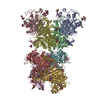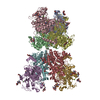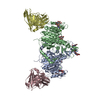+ データを開く
データを開く
- 基本情報
基本情報
| 登録情報 | データベース: PDB / ID: 7yix | ||||||
|---|---|---|---|---|---|---|---|
| タイトル | The Cryo-EM Structure of Human Tissue Nonspecific Alkaline Phosphatase and Single-Chain Fragment Variable (ScFv) Complex. | ||||||
 要素 要素 |
| ||||||
 キーワード キーワード | HYDROLASE / alkaline phosphatase / bone mineralization / catalytic network / hypophosphatasia / structural biology | ||||||
| 機能・相同性 |  機能・相同性情報 機能・相同性情報phosphoamidase / phosphoamidase activity / phosphoethanolamine phosphatase activity / pyridoxal phosphate metabolic process / response to vitamin B6 / futile creatine cycle / pyridoxal phosphatase activity / developmental process involved in reproduction / ADP phosphatase activity / biomineral tissue development ...phosphoamidase / phosphoamidase activity / phosphoethanolamine phosphatase activity / pyridoxal phosphate metabolic process / response to vitamin B6 / futile creatine cycle / pyridoxal phosphatase activity / developmental process involved in reproduction / ADP phosphatase activity / biomineral tissue development / inhibition of non-skeletal tissue mineralization / response to macrophage colony-stimulating factor / pyrophosphatase activity / cementum mineralization / Post-translational modification: synthesis of GPI-anchored proteins / alkaline phosphatase / alkaline phosphatase activity / response to sodium phosphate / phosphate ion homeostasis / inorganic diphosphate phosphatase activity / endochondral ossification / cellular homeostasis / response to vitamin D / bone mineralization / calcium ion homeostasis / side of membrane / extracellular matrix / response to glucocorticoid / skeletal system development / response to insulin / mitochondrial membrane / mitochondrial intermembrane space / osteoblast differentiation / positive regulation of cold-induced thermogenesis / response to lipopolysaccharide / response to antibiotic / calcium ion binding / ATP hydrolysis activity / extracellular exosome / extracellular region / membrane / plasma membrane 類似検索 - 分子機能 | ||||||
| 生物種 |  Homo sapiens (ヒト) Homo sapiens (ヒト) | ||||||
| 手法 | 電子顕微鏡法 / 単粒子再構成法 / クライオ電子顕微鏡法 / 解像度: 2.96 Å | ||||||
 データ登録者 データ登録者 | Yu, Y.T. / Yao, D.Q. / Zhang, Q. / Rao, B. / Xia, Y. / Lu, Y. / Qin, A. / Ma, P.X. / Cao, Y. | ||||||
| 資金援助 |  中国, 1件 中国, 1件
| ||||||
 引用 引用 |  ジャーナル: Nat Commun / 年: 2023 ジャーナル: Nat Commun / 年: 2023タイトル: The structural pathology for hypophosphatasia caused by malfunctional tissue non-specific alkaline phosphatase. 著者: Yating Yu / Kewei Rong / Deqiang Yao / Qing Zhang / Xiankun Cao / Bing Rao / Ying Xia / Yi Lu / Yafeng Shen / Ying Yao / Hongtao Xu / Peixiang Ma / Yu Cao / An Qin /  要旨: Hypophosphatasia (HPP) is a metabolic bone disease that manifests as developmental abnormalities in bone and dental tissues. HPP patients exhibit hypo-mineralization and osteopenia due to the ...Hypophosphatasia (HPP) is a metabolic bone disease that manifests as developmental abnormalities in bone and dental tissues. HPP patients exhibit hypo-mineralization and osteopenia due to the deficiency or malfunction of tissue non-specific alkaline phosphatase (TNAP), which catalyzes the hydrolysis of phosphate-containing molecules outside the cells, promoting the deposition of hydroxyapatite in the extracellular matrix. Despite the identification of hundreds of pathogenic TNAP mutations, the detailed molecular pathology of HPP remains unclear. Here, to address this issue, we determine the crystal structures of human TNAP at near-atomic resolution and map the major pathogenic mutations onto the structure. Our study reveals an unexpected octameric architecture for TNAP, which is generated by the tetramerization of dimeric TNAPs, potentially stabilizing the TNAPs in the extracellular environments. Moreover, we use cryo-electron microscopy to demonstrate that the TNAP agonist antibody (JTALP001) forms a stable complex with TNAP by binding to the octameric interface. The administration of JTALP001 enhances osteoblast mineralization and promoted recombinant TNAP-rescued mineralization in TNAP knockout osteoblasts. Our findings elucidate the structural pathology of HPP and highlight the therapeutic potential of the TNAP agonist antibody for osteoblast-associated bone disorders. | ||||||
| 履歴 |
|
- 構造の表示
構造の表示
| 構造ビューア | 分子:  Molmil Molmil Jmol/JSmol Jmol/JSmol |
|---|
- ダウンロードとリンク
ダウンロードとリンク
- ダウンロード
ダウンロード
| PDBx/mmCIF形式 |  7yix.cif.gz 7yix.cif.gz | 254.4 KB | 表示 |  PDBx/mmCIF形式 PDBx/mmCIF形式 |
|---|---|---|---|---|
| PDB形式 |  pdb7yix.ent.gz pdb7yix.ent.gz | 203.3 KB | 表示 |  PDB形式 PDB形式 |
| PDBx/mmJSON形式 |  7yix.json.gz 7yix.json.gz | ツリー表示 |  PDBx/mmJSON形式 PDBx/mmJSON形式 | |
| その他 |  その他のダウンロード その他のダウンロード |
-検証レポート
| 文書・要旨 |  7yix_validation.pdf.gz 7yix_validation.pdf.gz | 1.6 MB | 表示 |  wwPDB検証レポート wwPDB検証レポート |
|---|---|---|---|---|
| 文書・詳細版 |  7yix_full_validation.pdf.gz 7yix_full_validation.pdf.gz | 1.5 MB | 表示 | |
| XML形式データ |  7yix_validation.xml.gz 7yix_validation.xml.gz | 51.2 KB | 表示 | |
| CIF形式データ |  7yix_validation.cif.gz 7yix_validation.cif.gz | 76.2 KB | 表示 | |
| アーカイブディレクトリ |  https://data.pdbj.org/pub/pdb/validation_reports/yi/7yix https://data.pdbj.org/pub/pdb/validation_reports/yi/7yix ftp://data.pdbj.org/pub/pdb/validation_reports/yi/7yix ftp://data.pdbj.org/pub/pdb/validation_reports/yi/7yix | HTTPS FTP |
-関連構造データ
| 関連構造データ |  33865MC  7yivC  7yiwC M: このデータのモデリングに利用したマップデータ C: 同じ文献を引用 ( |
|---|---|
| 類似構造データ | 類似検索 - 機能・相同性  F&H 検索 F&H 検索 |
- リンク
リンク
- 集合体
集合体
| 登録構造単位 | 
|
|---|---|
| 1 |
|
- 要素
要素
-タンパク質 / 抗体 , 2種, 4分子 ABCD
| #1: タンパク質 | 分子量: 57020.188 Da / 分子数: 2 / 由来タイプ: 組換発現 / 由来: (組換発現)  Homo sapiens (ヒト) / 遺伝子: ALPL / 発現宿主: Homo sapiens (ヒト) / 遺伝子: ALPL / 発現宿主:  Trichopalpus nigribasis (ハエ) Trichopalpus nigribasis (ハエ)参照: UniProt: P05186, alkaline phosphatase, phosphoamidase #2: 抗体 | 分子量: 28830.195 Da / 分子数: 2 / 由来タイプ: 組換発現 / 由来: (組換発現)  Homo sapiens (ヒト) / 発現宿主: Mammalia (両生類) Homo sapiens (ヒト) / 発現宿主: Mammalia (両生類) |
|---|
-糖 , 2種, 8分子 
| #3: 多糖 | 2-acetamido-2-deoxy-beta-D-glucopyranose-(1-4)-2-acetamido-2-deoxy-beta-D-glucopyranose #4: 糖 | ChemComp-NAG / |
|---|
-非ポリマー , 3種, 8分子 




| #5: 化合物 | | #6: 化合物 | ChemComp-ZN / #7: 化合物 | |
|---|
-詳細
| 研究の焦点であるリガンドがあるか | Y |
|---|---|
| Has protein modification | Y |
-実験情報
-実験
| 実験 | 手法: 電子顕微鏡法 |
|---|---|
| EM実験 | 試料の集合状態: PARTICLE / 3次元再構成法: 単粒子再構成法 |
- 試料調製
試料調製
| 構成要素 | 名称: hALPL-scFv / タイプ: COMPLEX / Entity ID: #1-#2 / 由来: RECOMBINANT |
|---|---|
| 由来(天然) | 生物種:  Homo sapiens (ヒト) Homo sapiens (ヒト) |
| 由来(組換発現) | 生物種:  Trichopalpus nigribasis (ハエ) Trichopalpus nigribasis (ハエ) |
| 緩衝液 | pH: 7.5 |
| 試料 | 包埋: NO / シャドウイング: NO / 染色: NO / 凍結: YES |
| 急速凍結 | 装置: FEI VITROBOT MARK IV / 凍結剤: ETHANE / 湿度: 100 % / 凍結前の試料温度: 281.15 K |
- 電子顕微鏡撮影
電子顕微鏡撮影
| 実験機器 |  モデル: Titan Krios / 画像提供: FEI Company |
|---|---|
| 顕微鏡 | モデル: FEI TITAN KRIOS |
| 電子銃 | 電子線源:  FIELD EMISSION GUN / 加速電圧: 300 kV / 照射モード: FLOOD BEAM FIELD EMISSION GUN / 加速電圧: 300 kV / 照射モード: FLOOD BEAM |
| 電子レンズ | モード: BRIGHT FIELD / 最大 デフォーカス(公称値): 2800 nm / 最小 デフォーカス(公称値): 1000 nm |
| 撮影 | 電子線照射量: 50 e/Å2 / フィルム・検出器のモデル: GATAN K3 (6k x 4k) |
- 解析
解析
| CTF補正 | タイプ: PHASE FLIPPING AND AMPLITUDE CORRECTION |
|---|---|
| 3次元再構成 | 解像度: 2.96 Å / 解像度の算出法: FSC 0.143 CUT-OFF / 粒子像の数: 314858 / 対称性のタイプ: POINT |
 ムービー
ムービー コントローラー
コントローラー



 PDBj
PDBj






